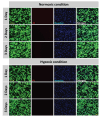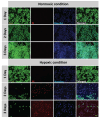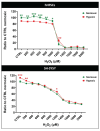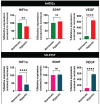Hypoxic Preconditioning Prevents Oxidative Stress-Induced Cell Death in Human Hair Follicle Stem Cells
- PMID: 39737203
- PMCID: PMC11682525
- DOI: 10.30498/ijb.2024.447077.3888
Hypoxic Preconditioning Prevents Oxidative Stress-Induced Cell Death in Human Hair Follicle Stem Cells
Abstract
Objectives: This study investigated the impact of hypoxic preconditioning on the survival and oxidative stress tolerance of nestin-expressing hair follicle stem cells (hHFSCs) and SH-SY5Y neuroblastoma cells, two crucial cell types for central nervous system therapies. The study also examined the relative expression of three key genes, HIF1α, BDNF, and VEGF following hypoxic preconditioning.
Materials and methods: hHFSCs were isolated from human hair follicles, characterized, and subjected to hypoxia for up to 72 hours. SH-SY5Y cells were similarly preconditioned for up to 72 hours. Cell viability under hypoxic conditions and oxidative stress was assessed. The relative expression of key genes was evaluated using qRT-PCR.
Results: hHFSCs exhibited remarkable resilience to hypoxic conditions, while SH-SY5Y cells displayed lower tolerance. Hypoxic preconditioning improved the viability of both cell types under oxidative stress. HIF1α mRNA was significantly downregulated, and VEGF transcripts increased after preconditioning, suggesting adaptations to prolonged hypoxia.
Conclusion: Hypoxic preconditioning enhances the survival and oxidative stress resilience of hHFSCs and SH-SY5Y cells, offering potential benefits for central nervous system cell therapy. The differential responses observed emphasize the need for tailored preconditioning strategies for specific cell types. These findings underscore the importance of hypoxic preconditioning and warrant further research into the underlying mechanisms, bringing us closer to effective neurological disorder treatments.
Keywords: EPI-NCSCs; HAP stem cells; Hypoxia; Priming.
Copyright: © 2021 The Author(s); Published by Iranian Journal of Biotechnology.
Figures






Similar articles
-
[Protective effect of hypoxic preconditioning on SH-SY5Y cells injured by oxygen-glucose deprivation].Zhongguo Ying Yong Sheng Li Xue Za Zhi. 2016 Apr 8;32(4):319-323. doi: 10.13459/j.cnki.cjap.2016.04.008. Zhongguo Ying Yong Sheng Li Xue Za Zhi. 2016. PMID: 29931955 Chinese.
-
Hypoxic Preconditioning Protects SH-SY5Y Cell against Oxidative Stress through Activation of Autophagy.Cell Transplant. 2018 Dec;27(12):1753-1762. doi: 10.1177/0963689718760486. Epub 2018 Jun 5. Cell Transplant. 2018. PMID: 29871517 Free PMC article.
-
Role of autophagy in protection afforded by hypoxic preconditioning against MPP+-induced neurotoxicity in SH-SY5Y cells.Free Radic Biol Med. 2010 Sep 1;49(5):839-46. doi: 10.1016/j.freeradbiomed.2010.06.004. Epub 2010 Jun 9. Free Radic Biol Med. 2010. PMID: 20541008
-
Priming of the Cells: Hypoxic Preconditioning for Stem Cell Therapy.Chin Med J (Engl). 2017 Oct 5;130(19):2361-2374. doi: 10.4103/0366-6999.215324. Chin Med J (Engl). 2017. PMID: 28937044 Free PMC article. Review.
-
[Hypoxic preconditioning of stem cells as a new approach to increase the efficacy of cell therapy for myocardial infarction].Vestn Ross Akad Med Nauk. 2013;(12):16-25. Vestn Ross Akad Med Nauk. 2013. PMID: 24741938 Review. Russian.
References
-
- Kahrizi MS, Mousavi E, Khosravi A, Rahnama S, Salehi A, Nasrabadi N, et al. Recent advances in pre-conditioned mesenchymal stem/stromal cell (MSCs) therapy in organ failure; a comprehensive review of preclinical studies. Stem Cell Res Ther. 2023;14(1):155. doi: 10.1186/s13287-023-03374-9. - DOI - PMC - PubMed
LinkOut - more resources
Full Text Sources
